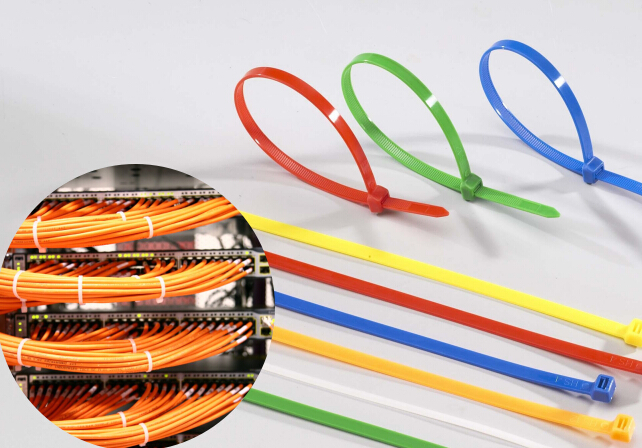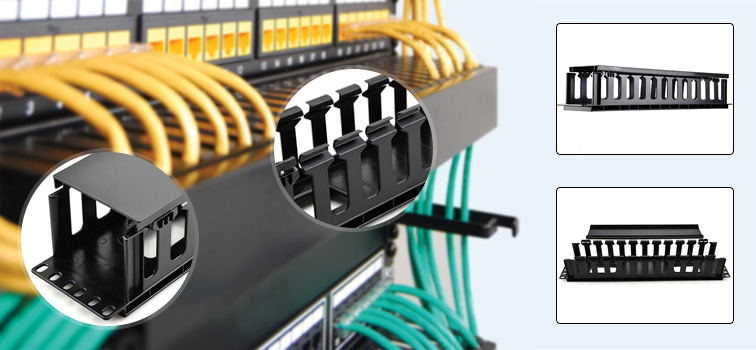Currently, most data centers and server rooms feature high density and large capacity, in which the devices and switches are installed on rack to achieve better performance and scalability. The accelerating capacity of network, therefore, brings a parallel growth of discrete data communication and power cabling. Apparently, to manage these massive data and cables within a confined and tightly-spaced rack environment is quite difficult. Improper cable management would result in cable damage and failure, which directly lead to data transmission errors, performance issues and system downtime. So, in this article, let’s talk about cable management in rack cabling systems.
Why Proper Cable Management Is Important?
Just as we have mentioned previously, poor cable management can cause a series of network problems. The following are the common ones.
Signal interference and crosstalk due to improper placement of data and power cables—Data and power cables running close to each other in parallel groups or in loops may create electromagnetic interference (EMI) due to induction. EMI can cause errors in data transmission over these cables. Therefore, power cables should be necessarily separated from data cables on the opposite side of the rack to reduce the chances of EMI.
Rack-mounted components blocked by improperly routed cables—Having the access to servers and other network components housed within an enclosure is critical. Due to the high density cabling of these applications, it is important to ensure that cabling does not block components, racks or rails. Fiber optic cables encounter additional challenges since they are more fragile. One should prevent other cables or components from exerting tension on fiber cables and avoid damage. Cable ties can be used to secure fiber optic cables. Try not to route fiber optic cable around corners within the enclosure.

Cooling and airflow restriction resulting from poor cable placement—It is important to make sure that cables are not placed in such a way that may restrict airflow from components inside the enclosure. Obstructed air movement due to blocked vents and fans lead to component overheating and possible thermal shutdown or even equipment damage.
Cable Management in Server Cabinets
At the very beginning, we should know that data centers generally contain two basic types of equipment enclosures: server cabinets and network cabinets.
Server cabinets house mostly active equipment in the form of blade chassis or stackable servers. The first step of preparing cable management for the enclosure is to determine the capacity needed for cabling. Calculate the number and type of connections per server and the total number of servers expected to be housed in the cabinet, then to determine where the cable needs to be routed.
Cabling Requirements Unique to Server Cabinets
Server cabinets typically have the patching for the devices occupying the rear-facing portion of the cabinet, along with power connections. This requires management of both network and power cords. The copper connections and fiber connections are served from one vertical bay, while power connections are addressed from another bay.
A mounting area is provided where vertical mounted power strips are used. In instances where power and network cords have to cross from one side of the cabinet to the other, the use of horizontal cable managers can be deployed to provide distinct paths. Noted that power and network cords should be housed in separate cable managers. The ability to house these connections in the vertical patching space assures that cables are dressed in such a manner that they do not block exhaust fans on the rear of the servers.

Cable Management in Network Cabinets
Network cabinets house network switches and patch panels. These cabinets have the highest concentration of cabling in the data center, making patch cord management even more critical and requiring both horizontal and vertical cable management. Due to the high concentration of cabling in these cabinets, a typical installation would use 19’’ patch panels and standard fiber enclosures mounted either at the top of the switch cabinet or in an adjacent cabinet when the cabinet houses multiple switches.
Cabling Requirements Unique to Network Cabinets
The majority of the patching connections typically occur at the front of the cabinet. For in row switching or top of rack switching, the back side rails populated with a horizontal cable managers allow patching within the cabinet and down the row.
Typically, the cabinets would be configured in a manner using rack mount patch panels and cable managers along with vertically mounted cable managers to provide pathways for patch cords transcending from top of rack patch panels to bottom of rack switches.
Tips for Specifying and Applying Cable Management Products
Start with proper planning—Once you have determined the amount of cabling and connections required, you can decide where the cables need to be routed within the cabinet. This allows you to select the proper cable management components to secure the wiring and connections. It is important to make sure that there is adequate space within the rack for the amount of cabling. Accurately establishing the amount of cabling and connections needed ahead of deployment will greatly increase the chance of a successful installation.
Keep growth in mind—Growth in data center environment is a necessity. Planning ahead for installing additional cabinets, servers and network components should be taken into consideration even as you are in the first phase of your rack installation. Which makes it easier to integrate additional racks and components in the future. Poor planning in terms of future changes often results in cable spaghetti that presented in many data centers.
Follow industry standards—Industry guidelines such as ANSI/TIA and ISO/IEC, as well as any federal, state or local regulations regarding cabling should always be followed. It not only assures code compliance but promises a safe, failure-free installation that will minimize system downtime and data errors. A standards-based cabling system provides the best combination of reliability today and the ability to change and reconfigure in the future. Standards provide a written foundation for establishing a sound infrastructure and guidelines for maintaining a high level of cable performance.
Summary
As we can see, poor cable management could lead to additional cost and time, while proper management contributes to reduce signal interference, improve maintenance and serviceability. To achieve successful cable management, professional skills and experiences are needed. And with the help of management products like cable manager and cable tie, you can even manage cables more efficiently according to specific layout requirements.
Originally published: http://www.china-cable-suppliers.com/achieve-cable-manage-rack-systems.html

No comments:
Post a Comment